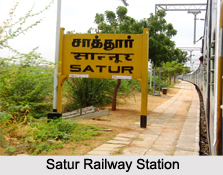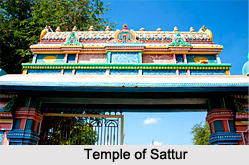 Satur is located in Virudhunagar district in the Indian state of Tamil Nadu. It is a town that has 8 taluks namely, Rajapalayam, Aruppukkottai, Sivakasi, Satur, Kariapatti, Virudhunagar, Srivilliputur and Tiruchuli. Being located on the bank of Vaippar River, the town has black soil that is apt for the cultivation of crops. Earlier Satur was under the Sivakasi Lok Sabha constituency but from 2009 it was shifted under the Virudhunagar Lok Sabha constituency.
Satur is located in Virudhunagar district in the Indian state of Tamil Nadu. It is a town that has 8 taluks namely, Rajapalayam, Aruppukkottai, Sivakasi, Satur, Kariapatti, Virudhunagar, Srivilliputur and Tiruchuli. Being located on the bank of Vaippar River, the town has black soil that is apt for the cultivation of crops. Earlier Satur was under the Sivakasi Lok Sabha constituency but from 2009 it was shifted under the Virudhunagar Lok Sabha constituency.
Geography of Satur
Satur is located at 9 degree 37 minutes 76 seconds latitude and 77 degree 17 minutes 6 seconds East longitude. The town has an average elevation of 56 metres above sea level.
Education of Satur
Satur has established several schools and colleges to promote education. Some of the important schools are located here. Some of these are Sri Little Buds Nursery and Primary School, Coranation English Medium School, Dr.Radha Krishnan Matriculation Higher Secondary School, Oxford Matriculation School, Sri Vanni Vinayaka School, Kamma Naidu Girls Higher Secondary School, S.H.N Ethel Harvey Girls Higher Secondary and many more.
Economy of Satur
The Vaippar River and Uppodai River are located on either side of the Satur. A dam has been constructed across the Arjuna River and Vaipar River for the easiness of agriculture.
Satur is known for its large scale cottage industries. The town specialises in manufacturing of fountain pen nib. Packialakshmi Nib Works is one of the well known nib industry in Satur. Apart from this the town also runs other small scale cottage industries such as fireworks, printing presses, tongue cleaner made of stainless steel and others. Fathima Steel Rolling mill has been producing tongue cleaners for almost four decades. Another booming industry of the town is the matchstick manufacturing industry. The firework sectors have timber depots and raw material suppliers. The mangai match works is one of the largest matchstick manufacturing units of the town. Satur also produces boxes to keep the matchsticks and racks for holding individual frames. The raw materials such as log wood required for the production purpose are supplied by towns located in the vicinity like Nagercoil, Tenkasi and the neighbouring state Kerala. The town is also known for producing a special type of chilly known as Satur Sanam. A particular type of light bathing towel known as Ramnad Mundu is also made here. 
Tourism in in Satur
Satur is an important pilgrimage centre with temples dedicated to Lord Shiva and Lord Vishnu. Odaipatti and Irukankudi near Satur have temples dedicated to Vinayagar and Mariamman respectively. All Fridays in the Tamil month of Aadi is regarded as auspicious in the temple. Thousands of devotees flock the temple during that time. Another temple dedicated to Lord Shiva dating back to almost 900 years is also located in Satur. The town also has an ancient masjid believed to have been built by the Mughal ruler Akbar. It is said that he constructed the mosque during his trip to Tamil Nadu. Satur as well as its neighbouring town Kovilpatti is famous for astrologers.
Visiting Information
The town is well connected to the nearby places by road and railway. Tourists can avail the private buses that ply from different places for the town. The nearest airport is located at Madurai at a distance of 77 kilometres. The nearest sea port is located at a distance of 80 kms from Satur. Trains are also available from Chennai, Bengaluru and Coimbatore. The town lies in the National Highway NH 7.



















